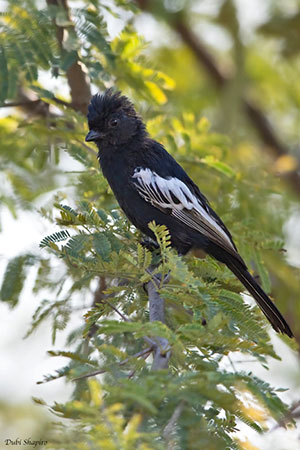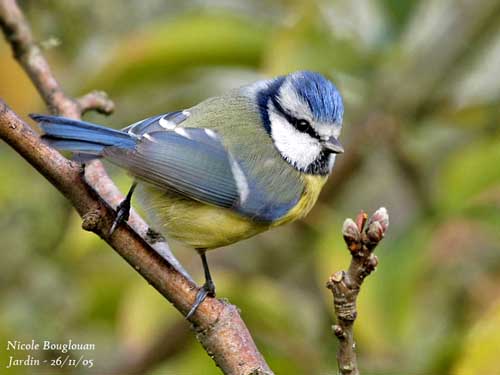
Text by Nicole Bouglouan
Photographers:
Didier Buysse
Vision d’Oiseaux
Jean Michel Fenerole
Photos d’Oiseaux du monde
Steve Garvie
RAINBIRDER Photo galleries
Tom grey
Tom Grey's Bird Pictures
René Lortie
http://rlortie.ca
Tom Merigan
Tom Merigan’s Photo Galleries
Niraj V. Mistry
Photo Galleries
Bob Moul
Nature Photography
Jean Michel Peers
JMPN PHOTOGRAPHIE
Jean Marc Rabby
Des Ailes et des Plumes
Dubi Shapiro
Dubi Shapiro Photo Galleries
Ingo Waschkies
My bird pictures on Pbase
Callie de Wet
GALLERY
Nicole Bouglouan
PHOTOGRAPHIC RAMBLE
Sources :
HANDBOOK OF THE BIRDS OF THE WORLD Vol 12 by Josep del Hoyo-Andrew Elliott-David Christie - Lynx Edicions - ISBN: 8496553423
THE HANDBOOK OF BIRD IDENTIFICATION FOR EUROPE AND THE WESTERN PALEARCTIC by Mark Beaman, Steve Madge - C.Helm - ISBN: 0713639601
THE COMPLETE BOOK OF BRITISH BIRDS – Written by “Royal Society for the Protection of Birds” experts - Préface de Magnus Magnusson - Michael Cady- Rob Hume Editors - ISBN: 0749509112
ENCYCLOPEDIE DES OISEAUX DE FRANCE ET D’EUROPE – de Peter Hayman et Rob Hume - Flammarion – ISBN : 2082009920
Wikipedia, the free encyclopaedia
FAMILY PARIDAE
Tits, Chickadees and Titmice
The Family Paridae includes 55 species split up into several genera.
The tits occur almost in all continents, except Australia, South America and the poles.
When we talk about tits, the famous Blue Tit (Cyanistes caeruleus) is always present in our minds. But the Family Paridae includes numerous other species, quite pretty and lovely. These small to medium-sized plump passerines often have soft plumage which colours vary greatly. Not many streaks or spots, but nice green, yellow and blue feathers, and also brown, grey, black and white patches.

Cyanistes caeruleus
Very active all day round, the tits frequent forested habitats, shrubs and several types of woodlands, but they often come very close to our habitations where they can find food in winter, shelters for nesting and protection in our backyards.
From the smallest (9-10 cm) dull Yellow-browed Tit (Sylviparus modestus) to the largest (20-21 cm) bright coloured Sultan Tit (Melanochlora sultanea), we can find numerous combinations of plumages. Several tits have a crest. This is the case of some species of the genera Periparus, Lophophanes, Baeolophus, some Parus and the single Melanochlora.
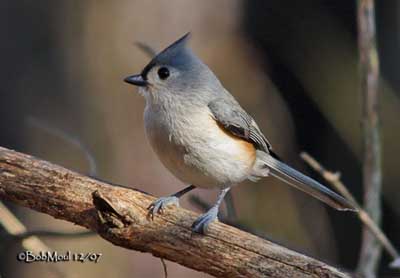
Baeolophus bicolour
The genus Poecile includes tits (Europe and Asia) and chickadees (North America). The members of this genus have black or brown head with white cheeks and black bib.
The upperparts can be grey or/and brown. Some variants show paler mantle in subspecies, but usually, wings and tail are dark grey to blackish. The back is grey, brown, pale buff or chestnut.
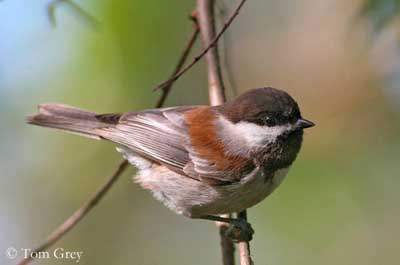
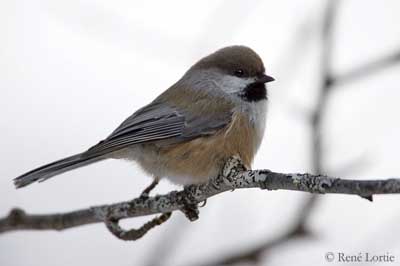
The colours of the underparts vary from white, greyish or pale buff to bright chestnut. These colours are often on body sides and flanks whereas the centre is paler or white. But some species show darker plumage overall.
The bill is blackish. The eyes are brown to dark brown. Legs and feet are greyish-blue.
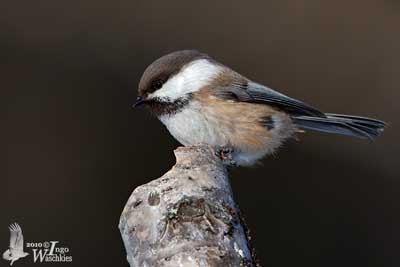
Grey-headed Chickadee
Poecile cinctus
The genus Periparus includes Old World species. The Coal Tit (Periparus ater) occurs in Europe and Asia. The other species are mainly from N India, N Asia, E China, Himalayas and Nepal.
These tits also have black head, white cheeks and black bib, which are important criterions in Paridae species, but they also show a vertical white stripe on nape.
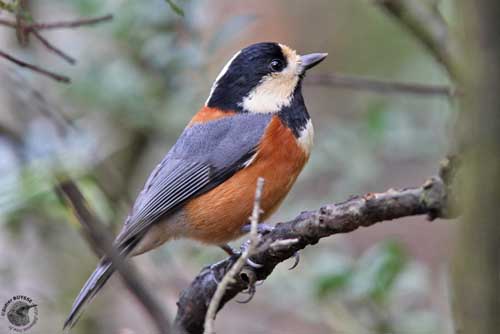
Varied Tit
Sittiparus varius
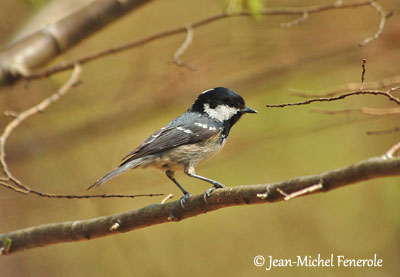
Coal Tit
Periparus ater
Most of them have yellow underparts with grey or brown upperparts and grey wings and tail. But some species such as the Palawan Tit (Periparus amabilis) have black head, bib and cheeks. The Coal Tit may have different appearance according to the subspecies, with white, yellow, buff or chestnut underparts. The Elegant Tit (Periparus elegans) from extreme N Philippines is yellow and black with two conspicuous white wing-bars.
The other species, Black-breasted Tit (Periparus rufonuchalis), the Rufous-vented Tit (Periparus rubidiventris), and the Spot-winged Tit (Periparus melanolophus) are darker and show a black crest on the hind crown. They have dark grey upperparts or entire body with chestnut patches on vent, underparts or flanks. The Black-breasted Tit and the Rufous-vented Tit lacks the pale wing-bars.
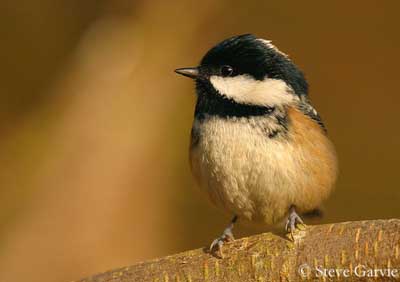
Coal Tit
Periparus ater
The genus Lophophanes includes only two species, the European Crested Tit (Lophophanes cristatus) from Europe, and the Grey-crested Tit (Lophophanes dichrous) from Nepal.
Both have soft colours with combination of grey-brown, grey and rufous, and conspicuous crest on the hind crown.
The European Crested Tit has white head, black bib and narrow collar, and scaled black and white crest. The subspecies can be more rufous overall.
The Grey-crested Tit has grey head and crest with brownish-grey bib and cheeks, and white malar stripe extending on the neck sides. The subspecies are darker and usually more rufous overall.
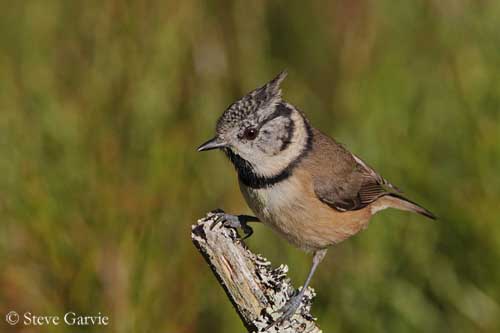
The members of genus Baeolophus from North America, and mainly the Bridled Titmouse (Baeolophus wollweberi), resemble the European Crested Tit.
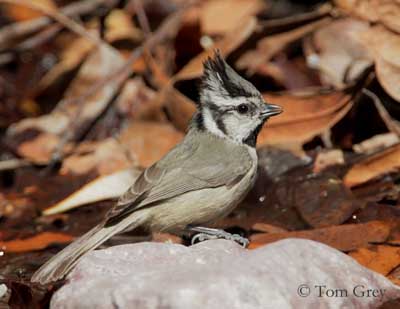
Bridled Titmouse
Baeolophus wollweberi
The five species show very soft colours, brownish-grey, grey, whitish-grey or creamy-white. The upperparts often are darker brownish-grey. Except for the Bridled Titmouse which has black and white head and crest with grey forecrown, the Oak Titmouse (Baeolophus inornatus) and the Juniper Titmouse (Baeolophus ridgwayi) are duller overall, with greyish or brownish head, paler face and short crest and very dull brownish-grey underparts.
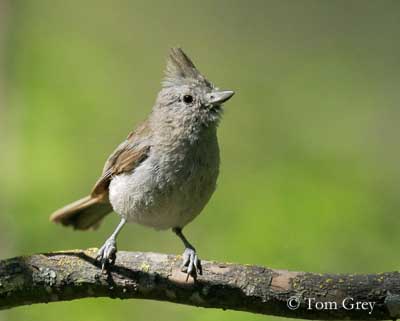
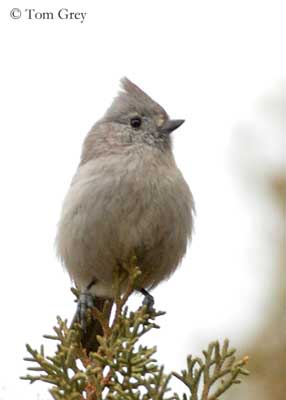
Oak Titmouse - Baeolophus inornatus
On the other hand, the two other species, the Tufted Titmouse (Baeolophus bicolour) and the Black-crested Titmouse (Baeolophus atricristatus), show more contrasted colours. Both have grey upperparts and white underparts with buff-rufous flanks. The head is pale grey and the cheeks are white. The Tufted Titmouse has black forehead and grey crest, whereas the Black-crested Titmouse has white forehead and black crown and crest, with grey nape and hind neck.
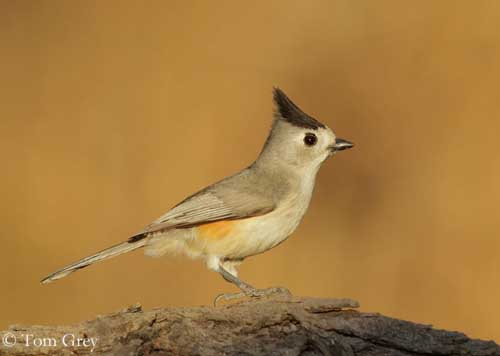
Baeolophus atricristatus
Within the genus Parus which includes 23 species among the largest, we can find 15 African species, now in the genus Melaniparus. The eight other species occur in Europe and Asia.
Seven of the African species are much darker, all black, or black and white. All are sub-Saharan species, some of them occurring in South Africa. They have black head and body, and prominent white wing-coverts, feather edges and shoulders.
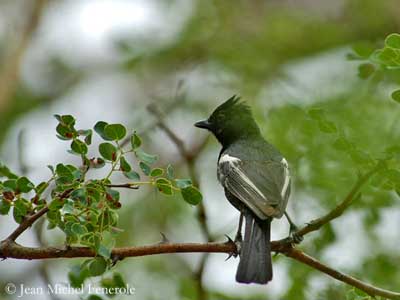
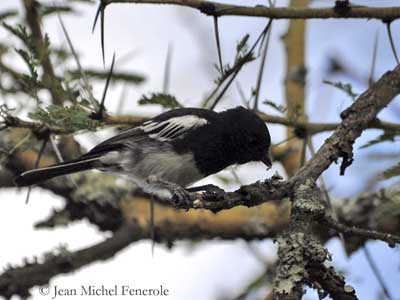
Southern Black Tit - Melaniparus niger
The White-bellied Tit (Melaniparus albiventris) shows white belly and vent. The Dusky Tit (Melaniparus funereus) male is entirely black whereas the female is ashy-black. They do not have any white patch. The only colour occurs in their deep red eyes. The White-backed Black Tit (Melaniparus leuconotus) has white back and black plumage overall. The White-shouldered Black Tit (Melaniparus guineensis) has white eyes.
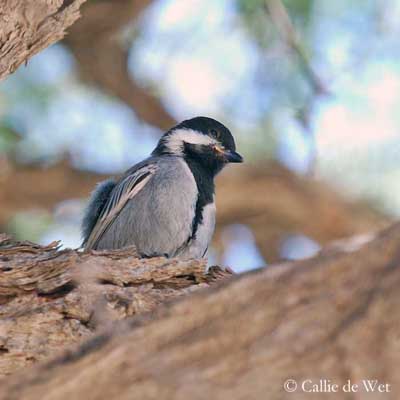
Ashy Tit
Melaniparus cinerascens
The eight other African species are paler and slightly coloured. The Rufous-bellied Tit (Melaniparus rufiventris) has black head and bib, pale yellow eyes, dark grey upper breast and back, and rufous belly and vent. The wings show white-edged feathers. The Cinnamon-breasted Tit (Melaniparus pallidiventris) is similar to previous except the buffy-white belly and vent.
The Red-throated Tit (Melaniparus fringillinus) has black crown, pale rufous head, neck and upper breast, grey upperparts with white-edged wing feathers, and dull brownish-grey lower underparts.
The Stripe-breasted Tit (Melaniparus fasciiventer) has black head, neck and bib, with black vertical stripe extending down to the lower belly. Rest of underparts are creamy-white. Upperparts are olive-grey with white-edged wing feathers.
The four remaining species are more typical of genus Parus with black head and bib, white cheeks, greyish-white underparts, greyer upperparts, dark grey wings and tail with white-edged feathers. The Grey Tit (Parus afer) has larger black bib, buff underparts and buffy-grey upperparts with few white edges. They have a black stripe descending to the lower belly, and some of them show white vertical band on nape.
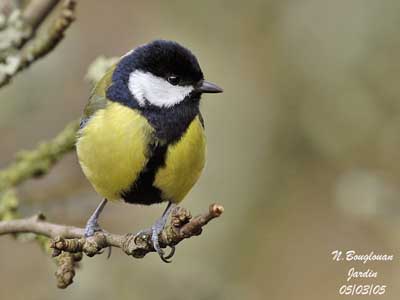
Parus major
The eight remaining species of genus Parus follow the four last African species and some of them show similar features such as white cheeks and black head and bib extending down to the lower belly. Wings and tail are grey to bluish-grey, the back is pale grey, greenish or bluish-grey and the underparts are pale yellow to whitish. The white-edged wing feathers are replaced by one or two white wing-bars. The Great Tit (Parus major) is a good illustration of this genus.
Then, we can find some tits with accentuated features such as larger black stripe on the underparts, white nuchal patch and large white wing patch or two wing-bars.
The White-naped Tit (Parus nuchalis) is the extreme between the previous birds and the following species.
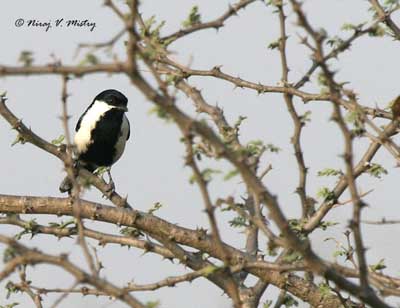
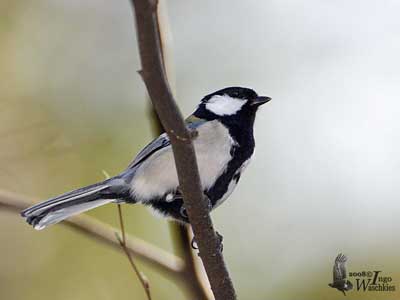
We find here several crested species with the same colours than previously, but with a conspicuous crest on the hind crown. These species show black crown, crest and bib, white or yellow cheeks, dark or black ventral stripe, black nape with paler patch (white or yellow), bluish-grey, buffy-grey, or yellowish-grey back with darker wings and tail, double white wing-bar and pale or bright yellow underparts, or greyish-white to buffy-white underparts in some birds. Some subspecies can be duller with slightly different wing pattern than nominates races.
The Yellow Tit (Parus holsti) has yellow underparts and lacks the black stripe, and the black crown extends down to the upper eye and ear-coverts. The white wing bars are very narrow.
The White-fronted Tit (Parus semilarvatus) is very different with its black or brownish-black plumage overall, except the white forehead and lores, and in addition, white wing patch in the subspecies P.s. nehrkorni from Mindanao in S Philippines.
The genus Parus is the largest of the family.
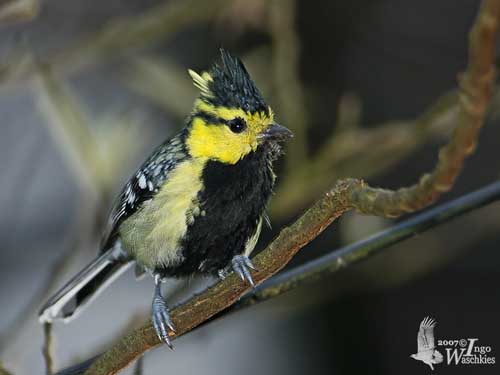
Machlolophus spilonotus
The genus Cyanistes includes three species, with the famous Blue Tit (Cyanistes caeruleus) from Europe, the African Blue Tit (Cyanistes teneriffae) and the Azure Tit (Cyanistes cyanus). These three species are blue and yellow or white. They have the typical head with white cheeks, but the black bib is much reduced with only black chin and upper throat, extending around the head until forming a narrow black collar. The crown is blue, bordered with white line from forehead to nape. The back is greenish-yellow. The wings are blue with dark grey flight feathers. We can see a white wing bar formed by the white tips of the tertials. The tail is blue too. The underparts are yellow with narrow black line crossing vertically from upper breast to belly.
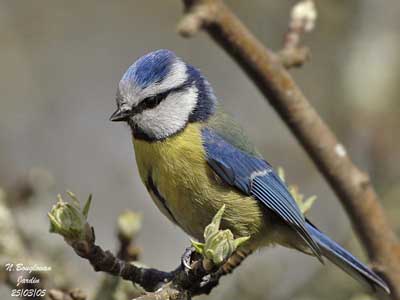
Cyanistes caeruleus
The African Blue Tit from Canary Islands is very similar but it is darker blue and lacks the white wing bars. Its plumage is more contrasted overall.
The Azure Tit from W and C European Russia to C Urals is white and blue. The upperparts show blue back and darker blue shoulders, wings and tail. We can see a conspicuous white wing bar and the flight feathers are tipped white. The tail is deep blue with white external rectrices. The underparts are white with narrow black vertical stripe on belly. The head is white with dark blue eye-line extending to the nape and descending to the shoulders. The nape is white.
The subspecies “flavipectus” and “berezowskii” may show some yellow on the breast.

Cyanistes teneriffae
The genus Sylviparus includes only one species, the Yellow-browed Tit (Sylviparus modestus) from Nepal. This one has dull greenish-yellow plumage overall with paler underparts and neck sides. A very short crest is visible on the crown. Very different from the other tits’ species, its behaviour and colours suggest some relationship with kinglets of genus Regulidae, but several other features are typical of the family Paridae.
The latest genus, Melanochlora, includes only one species too, the Sultan Tit (Melanochlora sultanea) from Nepal. This one is the largest species with 20-21 cm of length and almost 50 grams of weight. Its superb contrasted black and yellow plumage makes this bird unmistakable.
The long crest is bright yellow, as the lower underparts and undertail-coverts. The head, large bib and upperparts are glossy greenish-black. The bill is black or bluish-grey. The eyes are brown to reddish-brown. Legs and feet are blue-grey. The female has slightly paler bib.
The subspecies “gayety” from SC Vietnam has black crest and head.
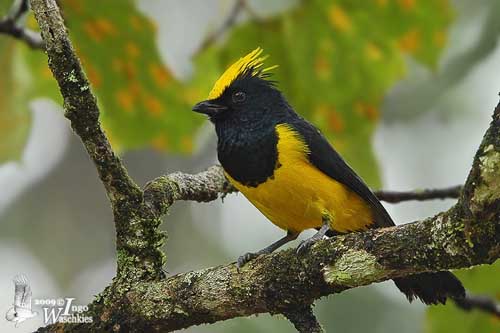
Sultan Tit
Melanochlora sultanea
All these species have fairly similar habits, nesting and feeding behaviour which will be studied in the following pages.
HABITS AND BEHAVIOUR
The Paridae species frequent a great diversity of habitats in the huge range over which they are found. They usually avoid the hot, cold or icy deserts, preferring vegetated areas and even wetlands to some extent. They occur in a variety of woodland types, but also in scrubs, parks and gardens in cities, towns and villages.
Tits are able to adapt. The Blue Tit prefers the oak woodlands and avoids conifers, but according to the range and the elevation, it can be found in cork oak in North Africa, and in pine and cedar woodlands in the Atlas Mountains.
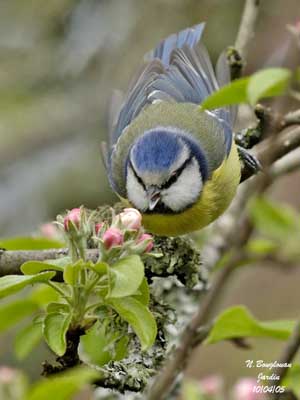
Cyanistes caeruleus
Some species live at high elevation. The Yellow-browed Tit lives at 2000-4000 metres of elevation and frequents oak and rhododendron forests, but it can move upwards into conifer woodlands and scrubby areas with willow along the tree-line, whereas the Sultan Tit is usually below 2000 metres in mixed deciduous/conifer forests.
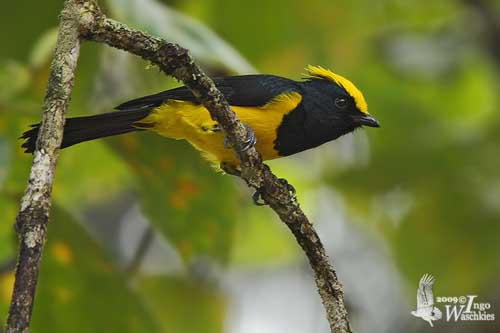
Sultan Tit
Melanochlora sultanea
Tits and chickadees of genus Poecile frequent the damp woodland or scrub, and the riverine woodland which are the typical habitats of the Marsh Tit, the Siberian (Grey-headed Chickadee), the Carolina Tit and some others. They need dead trees and stumps for nesting because some of them excavate the nest-cavity.
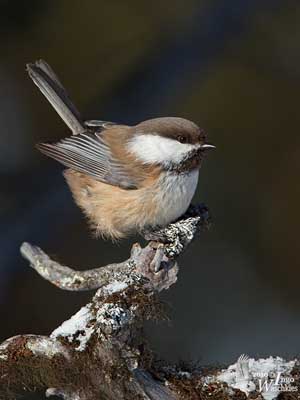
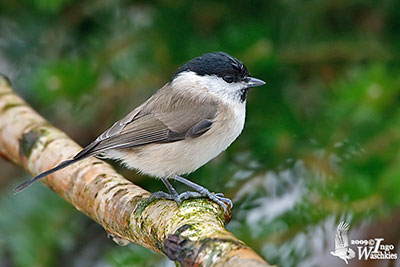
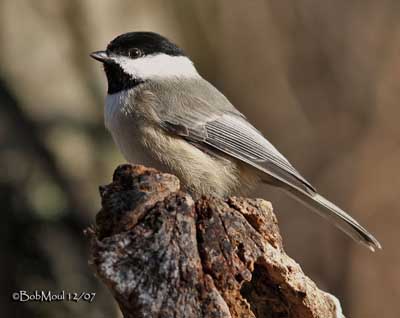
Carolina Chickadee – Poecile carolinensis
Grey-headed Chickadee – Poecile cinctus
The Periparus species occurs in diverse forest types such as secondary forest, edges of swamps and submontane areas. They like the mature forests and often breed at high density in conifer forest. Some species such as the Coal Tit have low breeding success in oak woodland. They do not excavate their nests.
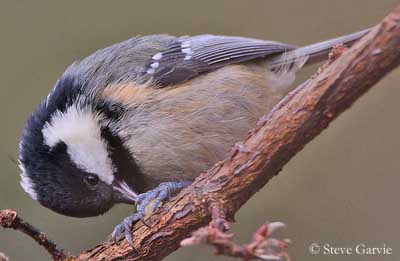
Coal Tit
Periparus ater
The two members of the genus Lophophanes prefer the conifer forest in the northern parts of their range. However, in C and S Europe, they occur in wide range of habitats including deciduous woodland. They can live at high elevation and need dead trees to excavate their nests.
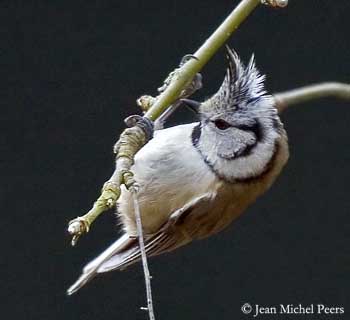
Lophophanes cristatus
The Baeolophus titmice also are forested species. The Oak Titmouse occurs mainly, of course, in oak and oak-pine woodland, whereas the Juniper Titmouse inhabits the Juniper forests of the inter-mountain areas. The Bridled Titmouse occupies similar habitat but has distinct foraging niche due to its smaller size.
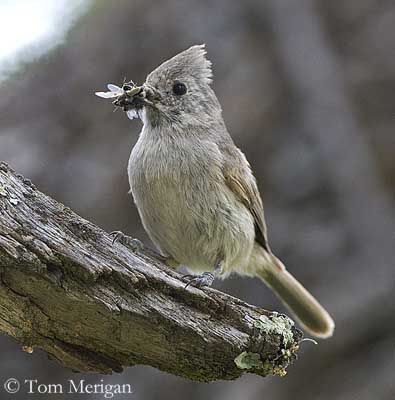
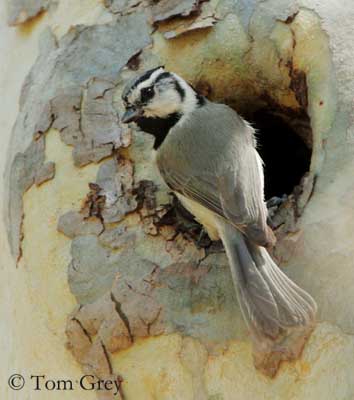
Oak Titmouse – Baeolophus inornatus
Bridled Titmouse – Baeolophus wollweberi
The genus Parus is present in almost every Old World habitat in which this family occurs. The African birds occur mainly in open or wooded savannas. Some of them from NC, EC and C Africa, extend into the savanna edge of the rainforest, riparian thickets, forest or woodland, and gallery forest. The South African species tend to be associated with water. The other African species frequent a great diversity of montane forest and woodland habitats.
The remaining Parus members are present in every vegetated habitat of the Palaearctic and Oriental regions. The Great Tit, the most representative of all species, occurs in every kind of forest, scrub or bushy habitat, but it is the only member associated with mangroves and lowlands, and it is rarely seen above 2000 metres of elevation.
The members of genus Parus do not excavate the nesting cavity.
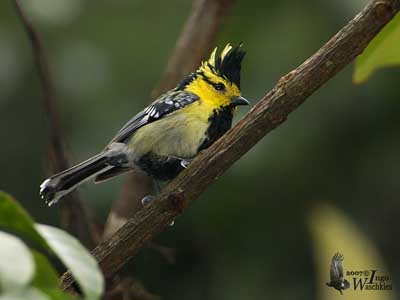
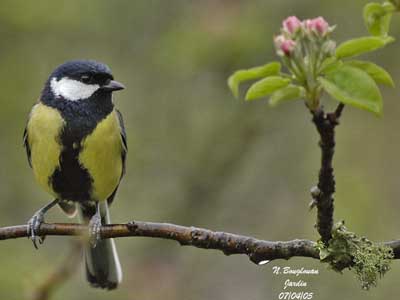
Yellow-cheeked Tit – Machlolophus spilonotus
Great Tit – Parus major
Finally, all the species more or less frequent the same type of habitat according to the range and the season.
Outside the breeding season, the tits occur in wider range of habitats. These birds feed on invertebrates during summer, and take seeds in winter, that explains the adaptation from a habitat to another one. The breeding habitat must have dead trees, stumps and snags for most species, to excavate the nesting hole.
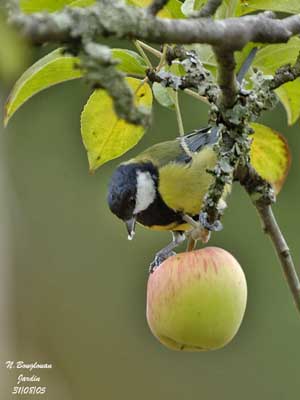
They often occur in parks and gardens where they take advantage of food provided by humans.
Orchards and olive plantations, edges of cultivated areas, or mixed gardens/cultivations are associated with several tits species too.
Parus major
These birds are vulnerable to deforestation, involving more restricted breeding areas and separation of the populations. The birds have to cross large areas between them, and are more exposed to predation risk. The breeding success is lower in small woodland patches than in continuous forests, and the gene flow is reduced between each populations.
From a British study, Great Tit and Blue Tit breeding performances have declined with the decreasing size of the woodland patches.
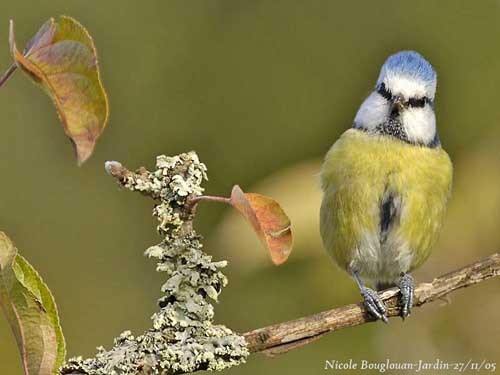
Cyanistes caeruleus
The Paridae species feed on invertebrates and seeds, and some fruits. The nestlings are fed with caterpillars and small insects, and the seeds are consumed outside the breeding season.
According to the size of the bird, the tits forage in different way. The larger tits usually hop on the ground, searching for food in the leaf litter. They also hover for short periods and use a hanging posture to reach some food items, but less frequently than the smaller birds which are more agile.
The chickadees and the small titmice glean from foliage by hovering and hanging by one or both legs and upside-down, from twigs and small branches often with kinglets and warblers, whereas the larger species forage in the bark crevices as nuthatches and tree creepers.
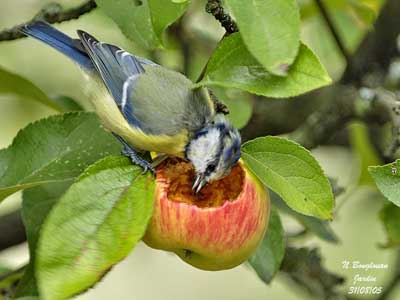
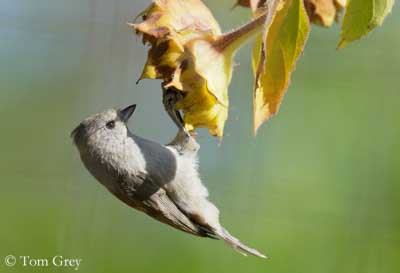
Blue Tit - Cyanistes caeruleus
Oak Titmouse - Baeolophus inornatus
Hanging is the main foraging method for all the Cyanistes species, and also for some other Poecile and two Parus. The smaller species are also known to pursue insects in flight.
The birds with heavy bill such as Parus, Baeolophus, Poecile and Cyanistes also hold the item under one or both feet and repeatedly strike the food from above with the bill. The large caterpillars are killed in the same way before to remove the head in order to feed the chicks safely.
Blue Tit feeding on sunflower seed
Click on the link and move the cursor
The Paridae, as other birds’ species, are territorial during the breeding season and more gregarious the rest of the year.
The advertising songs declare the territory. The birds defend their area by different types of behaviour, usually songs and displays. They adopt typical threatening postures which enhance the plumage pattern, chase the intruders away from the territory, and some fights may occur.
The breeding period begins with the break-up of the winter flocks. Several aggressive interactions occur between males while they try to establish their territories. The pairs form or re-form.
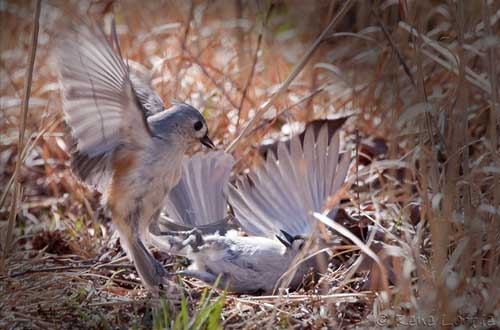
Baeolophus bicolor
The displays, as well threat or courtship, are accompanied by calls and songs. These gregarious species are fairly vocal with quiet or louder contact calls while feeding. Their calls range from quiet notes, through soft to harsh, scolding or scratchy sounds, and to more or less explosive calls. The frequently repeated notes of Paridae uttered in rapid phrases indicate the type of situation such as the level of a threat.
The sounds given during the courtship displays are usually higher-pitched. A female defending the nest may give snake-like hisses, accompanied by wing-flick and fanned tail.
The song is associated with breeding, in order to attract a mate and has also a territorial action.
It may be given at any time of the day, mainly at dawn during the breeding period.
The males have large repertoires, and those that sing more than others are socially dominant. This is also a signal of male’s quality and females are known to prefer to pair with such males.
The Paridae songs are often repetitive and vary greatly. Some of them can be compared to those of Turdidae species.
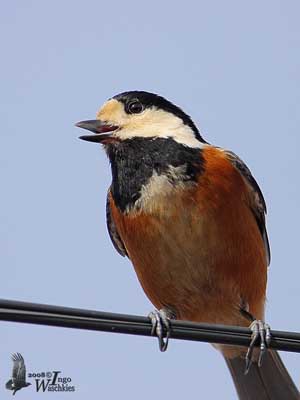
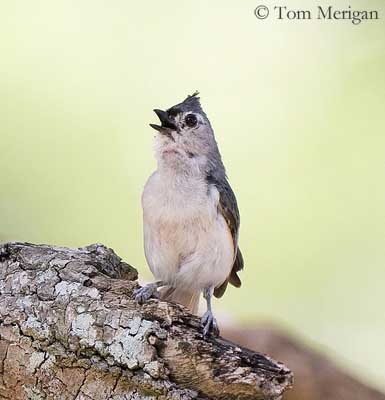
Varied Tit - Sittiparus varius
The song is an important facet of courtship displays, but body size and plumage pattern also play a role in mate preference. To enhance these features, the birds adopt exaggerated postures with head-up displays in Parus, Poecile and Cyanistes species.
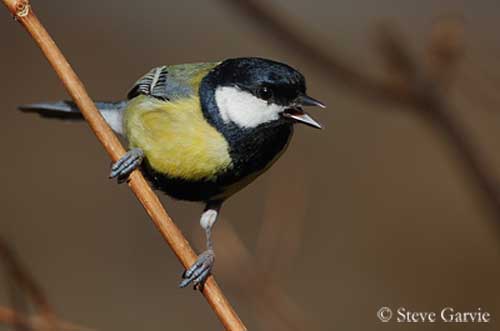
Parus major
Tits are also known to perform courtship feeding by male to female during the breeding period. They are usually monogamous with long pair-bonds. The season often begins with these rituals. The male offers an insect or any food item to the female which receives it with wing-shivering displays and high-pitched chirping notes, begging food to the male as the chicks do.
This gift is another signal of male quality: it will be able to feed the chicks. And this food is a nutritional supplement for the female while she is developing the eggs.
Courtship feeding between Blue Tits
Click on the link and move the cursor
All tits nest in holes, in various natural or artificial cavities and nest-boxes when available. Most of the species use a tree hole, and the members of the genera Poecile, Baeolophus and Lophophanes excavate their own nest-hole in dead trees. Several Periparus nest in holes on the ground, as well on a sloping bank as in old mice hole.
Usually, both mates excavate the hole, but the female alone builds the nest inside. The base is made with a pad of moss (between 1 and 8 cm of depth). But the moss may be replaced by grass or dry vegetation, with addition of hair and feathers, when the moss is not available. This is the case of the African Blue Tit.
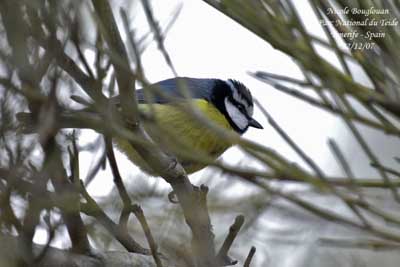
Cyanistes teneriffae
But if hair is used by all tits as lining, the use of feathers is not so common. In fact, feathers could be used more as distraction and lure for predators to find the eggs than as lining function.
The nests of the Baeolophus species are more complex with several plant materials, hair and feathers, but also snakeskin in the case of Tufted Titmouse and Black-crested Titmouse.
The tits living in dry conditions have a base made with wood chips.
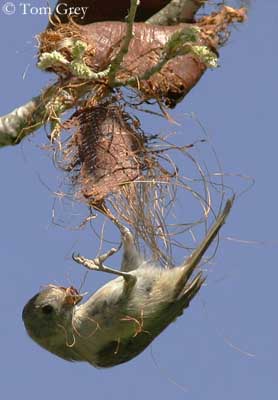
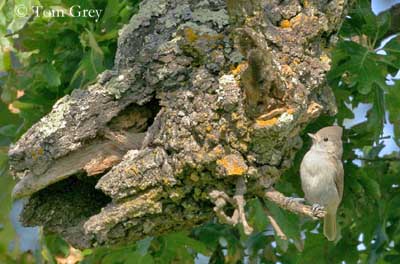
Oak Titmouse - Baeolophus inornatus
Collecting nest materials (left) and at nest (right)
While building the nest, the female uses her breast to form the shape. When feathers are used, they often are piled on top of the eggs. She roosts in the nest-cavity until the young fledge, whereas the male uses another smaller hole within the territory.
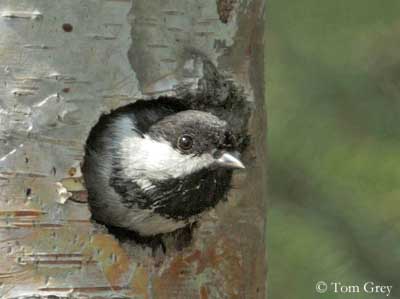
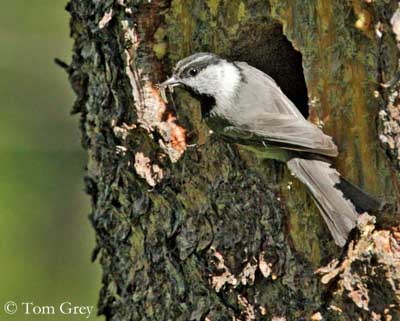
Once the nest is built, the eggs are laid at daily intervals. The incubation begins when the clutch is complete. The clutch size varies according to the species, but usually, tits have large ones. The species living at higher, temperate latitudes lay more eggs than the tits living at lower, tropical latitudes.
The Great Tit may have 12 eggs in Europe, whereas the Oriental Parus species lay 3-7 eggs, and the African species 2-4 eggs.
It appears that the number of eggs laid by females is related to what the pair will be able to raise, to get the best breeding success. A second clutch is laid when there is sufficient prey availability.
The Coal Tit which is closely associated to conifer forests may lay a third clutch, because the evergreen woodlands provide prey abundance.
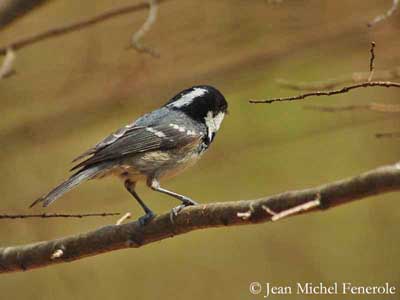
Coal Tit
Periparus ater
The incubation period may last between 12 and 14 days, but it may be longer in the northern parts of the range, up to 18 days in the case of Grey-headed Chickadee and European Crested Tit.
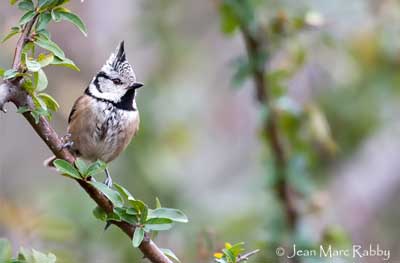
Lophophanes cristatus
The chicks are fed by both parents. In some species such as Baeolophus and the African Species, co-operative breeding may occur and parents are helped for raising the young. The nestlings grow rapidly and fledge between 16 and 22 days according to the species. The parents induce the chicks out by presenting the food from outside the hole. Usually, once the first chick has left, the others follow. The period of dependency may vary between 21-45 days, 50, 60 and up to 80 days for the Varied Tit.
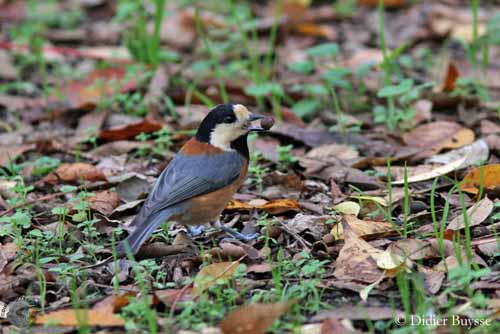
Varied Tit
Sittiparus varius
In group-territorial strategy, the dependency period is very short, between 6 and 8 days for Great Tits and Blue Tits. The flocking species are more protected against predators and avoid food competition.
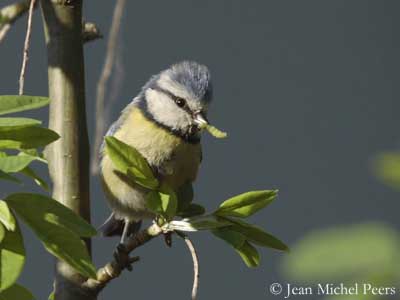
Cyanistes caeruleus
The Paridae species perform short flights with rapid wing-beats. They can hover briefly when they forage in the vegetation.
On longer distances, the usual flight is undulating, with active wing-beats interspersed with glides.
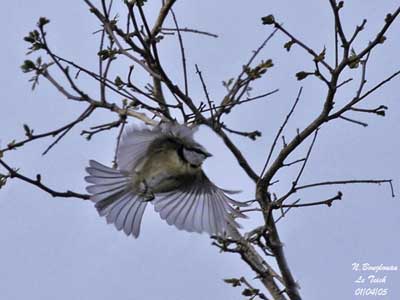
Cyanistes caeruleus
The family Paridae is one of the most sedentary families of passerines. We can find three types of movements with first, the dispersal movements of the juveniles after the nesting period. They move to search for food after they become independent, and they need to find their own territories.
Paridae also perform altitudinal movements. The birds living at high elevation descend to lower levels for wintering in more temperate conditions. But they often remain above 2000 metres and these movements are only partial migrations. Many birds, usually adults, do not move and spend the winter period at high altitude.
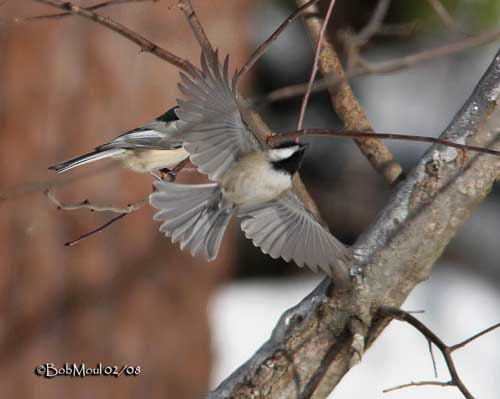
Poecile atricapillus
The eruptions are caused by failure of seed crops. Several tit species irrupt into an area beyond their usual range, that involve competition for food with other species. The local birds are normally dominant, but the weaker plumage patterns of the winter may change the dominance status. But the movements are performed over relatively short distances.
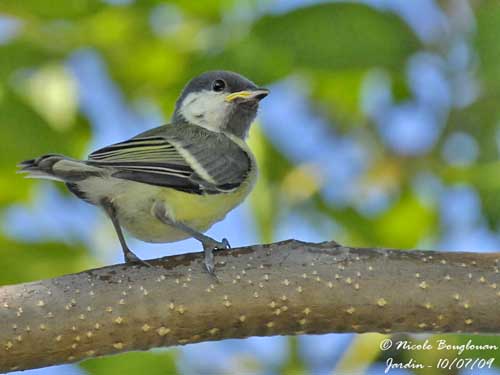
Only some oriental species are classified as Near Threatened and the White-naped Tit as Vulnerable. The main threat is the loss of their habitat with fragmentation and degradation of their areas, involving rapid declines.
Some Asian birds such as the Varied Tit are trapped for pet-trade.
Two African species, the Red-throated Tit and the Miombo Tit are at risk due to habitat
degradation.
All species are threatened by deforestation and fragmentation of wooded habitats. Competition for nest-holes between several species may involve declines too.
However, several Paridae species have extended their range in recent years and the populations are evaluated as Least Concern and are not globally threatened. The availability of nest-boxes has involved better reproduction success, and the food provided by humans during winter through the bird-feeders, is also a good help when the natural food sources are lacking.
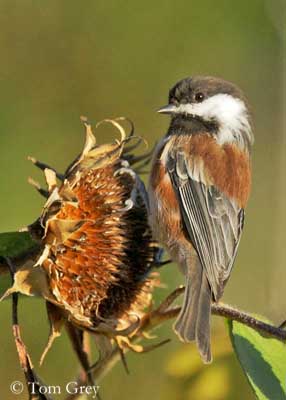
Poecile rufescens
